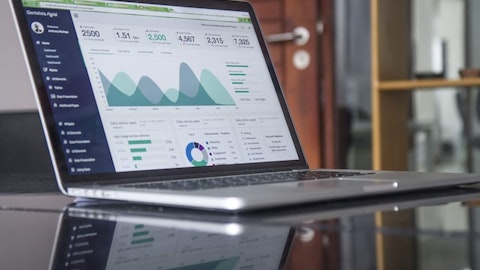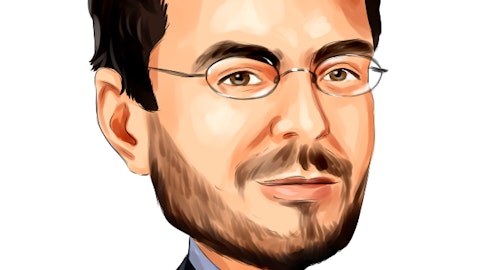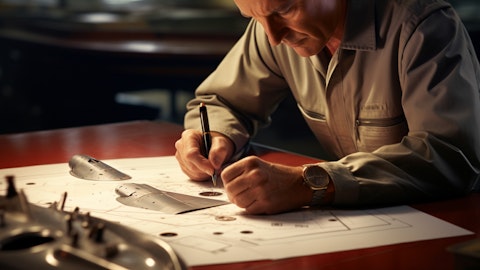But overall it’s accretive. We’ve — we’re being pretty disciplined about that. We use Salesforce.com and Tableau. So we have contemporary tools to house all of our pipeline activity as well as our one business. And then it goes out by quarter on the use of cash for both capital and working capital. So we can see what we’re obligating the company to and for periods. We being capital efficient so the show is still going here, filling in the future periods and I’m not ready yet to discuss exactly how accretive it is but I’ll take that as an action item and for the next call.
Rob Brown: Okay, great. Thanks for all the color there on. And then he went through several categories of the new business activity but grid in electrical activities was one of the areas you highlighted. What do you sort of seeing there in terms of activity and how do you see the growth looking in that area.
Harold Bevis: So we have two main product lines there. One is you know your old fashioned circuit breakers and distribution box electrical distribution and control, any others grid edge devices for control of the grid. In the case of grid — grid edge devices or smart meters and that sort of thing. They’re actually used in electrical and water. And so if you look at the public filings by our customers there, they’re growing in both water, utility control and electrical utility to control. Their customers are utilities and cities and municipalities and water districts and so on the grid edge devices, which were associated with they’re seeing steady growth. Then we have a good mix there. On electrical distribution and control a little different because we’re tied in mainly again to residential and that’s tied into the same dynamic as I mentioned earlier for us on shafts in our machine business.
That one though we’ve had some decent amount of new wins. And so we’re not turning down in that area due to share gain. But the base business is a little softness. I think contactors, connectors, grounding on an all types of electrical distribution across points. So we’re able to make that with powdered metal. We have powdered metal products as well as assembled copper bar and bus bar. So overall, it’s growing a little bit and has sizable backlogs, sizable backlogs. So in that arena, our customers talk about book-to-bill, and there’s a couple-year backlogs. The backlogs go over a couple of years.
Rob Brown: Okay. Great. Thanks for the color. I’ll turn it over.
Harold Bevis: Thank you, Rob.
Operator: The next question will come from Mike Crawford with B. Reilly. Please go ahead.
Mike Crawford: Thank you. You’ve given some prior pipeline information, like you had a $500 million pipeline a year end. Did you state what the pipeline is currently?
Harold Bevis: It’s grown a little bit. It’s closing in on around $550 million, Mike.
Mike Crawford: Okay. And then I was hoping you could maybe elucidate on how these new program wins layer in to your existing base of business. So NN Inc. had, what, $489 million of revenue last year, but, is there like a related metric of how much of that is somewhat recurring or somewhat bleeding off?
Harold Bevis: Yes. So there’s a few important metrics. One is that the average time from securing an award nomination, which is the industry angle, to hitting peak annual sales or run rate sales is about 18 months. Generally speaking, we’re a Tier 2 provider to a Tier 1 making a subsystem that’s going through their internal development in the case of vehicles, vehicle crash testing and vehicle certification, and PPAPing, which is a quality term used in the industry. So a vast majority of our new wind profile is at 18 months from award to peak annual sales. On the second point you touched on, which was comparing last year to this year, I think the inferred question is why isn’t it going up more now? That gets into the lack of winning that was going on in 2022 and early 2023 that would have manifested itself around now.
So there will be an inflection on the contribution of new business onto our base business. What’s the takeaway? Business that’s going through end-of-life production, EOP, end-of-production and we have looked forward, and we kind of know what that is, and we know what the look of it is. And our goal is to do much higher growth than market growth. And so the business we’re securing, if you do the math on it, you know, we’re $165 million on $500 million. So that’s way above our market growth. Our market’s growing 3% to 5%. You know, we’re winning around 13% to 15%. The takeaway is in the production, which is just a — gets into single digits takeaway. So the game plan here is to create a growth portfolio that layers in, gives us the confidence to say no to continuation of underperforming business and walk away.
And we’re just starting. So we’re right at four quarters here since Tim and I have been here. And the commercial team, which is led by a gentleman named Verlin Bush, Verlin was new in the job after I got here. I promoted him into that position. And he’s been winning — his team has been winning at a much higher rate than the company ever has. And it’s not slowing down. So the net amount is coming to us in future quarters. Sometimes we’ll get dropped in business, Mike, like in the first quarter. We did have a decent amount of immediate startup wins. Immediate startup usually means it’ll start in two or three quarters versus five or six. And right now inside the company, we’re launching close to 40 programs, which is a very high level of new product launching than the company’s ever been associated with.
And Tim’s put in place a phase gate program, phase zero program, and PPAPing discipline. And he’s bolstered his ops team with professional managers who’ve done this at a high level — a mass quantity. So if the numbers and then it’s do it properly so you don’t stumble. And right now, we’re operating near our capacity for our ability to quote much and we have space on CapEx to do more, but these programs need to be implemented. So we’re kind of comfortable with where we are right now Mike, not ready to take that aspiration part of our go-forward plan up. We’re really committing to do that amount. And when we — proven we can launch programs and they are accretive, and we do post-mortem and we get it right, and its muscle now, we will look at taking up the dollars of growth that we intend to get, the markets there.
We’re seeing opportunities. We’re just kind of cherry picking right now. Tim, anything else? Any other modifiers on that?
Tim French: No, again, Harold, I think you nailed it. I wouldn’t have anything to add to that. Thank you.
Harold Bevis: Thanks, Mike.
Mike Crawford: Okay. Thank you. Just one follow-up to that question. So when you have your 18 months on average from award to peak revenue? And then what on average is the ELP tail after that.
Harold Bevis: Are you asking, how long do we generally retain a program?
Mike Crawford: Yes.
Harold Bevis: Its around eight years. So they’re like annuity strips. If you look at the amount of business per year, numerically that the company has, it’s not all eight year business. We have some PO business too, but it times out. And then needs to be replaced. So let’s say, the net amount, the net amount probably half of the win rate we’ll get smarter on that for the next call, Mike.
Mike Crawford: Okay. And then just a final question for me. So you’re right now thinking you can capture another $10 million of EBITDA once your restructuring actions are completed, particularly at these — maybe four other plants that remain on — the low profitability arm. What is the anticipated span that you need to invest to achieve this goal? And maybe, if you could frame that in the context of EBIT versus adjusted EBITDA that would be very helpful for us. Thank you.
Harold Bevis: Okay. Look, I’m going to talk a little Tim and Mike on the adjusted EBIT – EBITDA. The business that we spoke about, that loses money in 2023, we had about $100 million of business that lost a little more than $10 million at the plant level. We articulated a goal to rationalize that business, trying to retain business trips that were good, but to increase in 2024 versus 2023 about $10 million of EBITDA. So if you do that math, that gets about — back to about break even on an annualized basis. But that’s not the end point for those assets, the goal really is to get to plus $5 million. So then, you say, how much capital is needed to get from minus 10 to zero? Basically, nothing not much de minimus. The second part of your question is, so how much capital would be needed to get from zero to plus 5.
Okay. Different — that’s a different question. So right now Tim and I foresee some capacity rationalization, which will take some money, plant closures, plant consolidations or whatever color you want to put on. It will also take us going in first — a couple of hard talks with a few customers not a lot but few, and then in the case of assets that become idled through that process, do you move them or do you modify them? Right now Tim and I think a conservative assumption is that we’re going to have to modify some of the equipment to be able to compete and be repurposed into our growth program. So that has a use of capital. And that’s one reason Tim’s looking for 12 quarters here, against our current capital market constraints. And right now it all works, so we’re going to be probably 60-40 CapEx on growth versus cost.
We haven’t spent a lot of capital on cost since we’ve been here. We’ve been using it mainly on growth and maintenance of business, but we’re going to need to spend some money on making that capacity profitable on a go-forward basis, either through facility rationalization or investment in equipment so it can be repurposed to do something else. I’ll hand it to Tim, and then Tim, if you’ll hand it to Mike on the financial question.
Tim French: Sure. And we’re putting that analysis together now, so I wouldn’t want to quote a number as far as what the capital required for that is because we’re just finalizing that, and we can take that as an action item for future calls, but Harold is completely correct. It was virtually no capital to — or will be virtually no capital to get that group facilities to break even. But there will be some form of capacity rationalization, and it will require capital, but at this point I couldn’t quote a number.
Harold Bevis: We’re working within our overall idea of spending around $20 million, Mike, on CapEx, so right now we’re not letting go of that constraint self-imposed on ourself. And then on the third point, on EBITDA, Mike, would you handle that one?
Mike Felcher: Yeah. I think you covered it in the sense of the $10 million is embedded in our 2024 outlook relative to 2023, and then going forward, as Tim said, if we spend some CapEx for facility rationalization, that wouldn’t impact EBITDA, and if we had any costs incurred for plant consolidation, we would typically exclude those from our adjusted EBITDA, but yeah, it would be defined in terms of capital and expense for future footprint decisions at this point.
Harold Bevis: Mike Crawford, on plant consolidations, as you know, no one likes adjusted EBITDA, us included, but there’s some gap accounting to follow if you’re going to consolidate a facility. And so I would say we’re not going to do anything other than follow gap accounting on rationalization that we’re going to do. And it’s not a big thing. It’s a minor thing. It’s not going to be a big use of capital, but it’ll be a use of capital, and at Tim’s point, we’ll get our arms around it and be able to give numerical information next time.



